Although I went to sleep in the train in Tbilisi on Tuesday evening, I was supposed to wake up in Georgia's Second City, Gori. The train was scheduled to leave Tbilisi at three o'clock in the morning but it was actually around four when we left. With not much to see in the dark, I went back to sleep and, when I awoke at six, we were stationary in Gori station. Breakfast on the train started at 7.30 a.m., allowing me to watch the comings and goings on the other two platforms.
At nine o'clock, we walked the short distance from the train to the car park where our tour buses were lined up.

Gori Station: Georgian Railway
Gori was the birthplace, in 1878, of Iosif Vissarionovich Dzhugashvili better known as Joseph Stalin ('Stalin', from the Russian word for steel was originally a nickname alluding to his strong beliefs). The original one-roomed semi-detached house where Stalin was brought up remains, in situ.
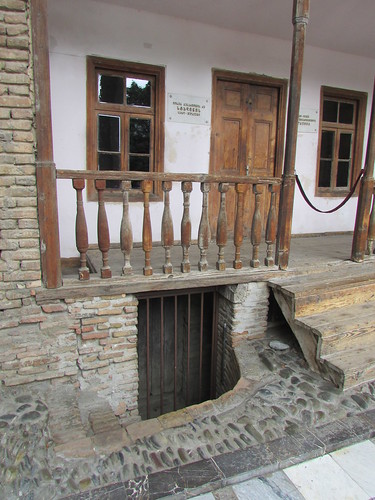
Stalin's Museum, Gori, Georgia: The 1-room semi-detached rented dwelling where Stalin grew up. The basement formed his father's shoemaker's workshop.
Rather incongruously, this humble dwelling is now protected by a rather grand columned pavilion. All the other old houses which originally surrounded Stalin's house have gone and the area is now formal gardens.
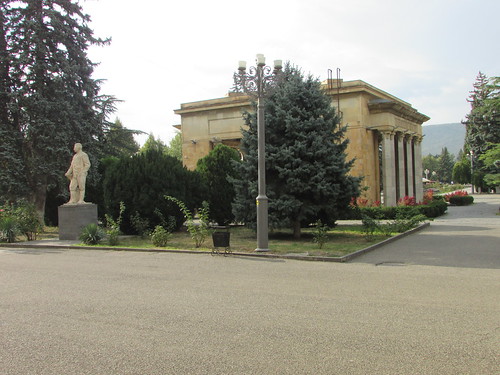
Stalin's Museum, Gori, Georgia: The columned pavilion protecting Stalin's house, now set in formal gardens with a nearby statue of Stalin.
Adjacent to the preserved house, there's now a large museum building where Stalin's life is documented in great detail, in a Soviet, hagiographic style.
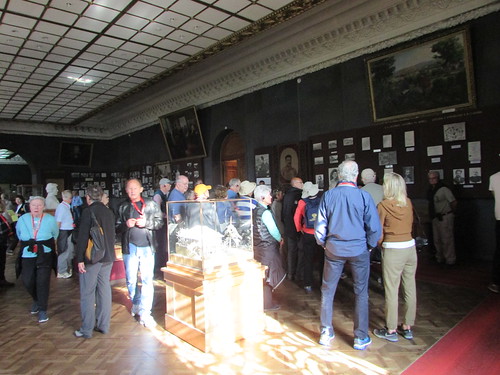
Stalin's Museum, Gori, Georgia: The model in the glass case shows a simple Dacha.
After achieving power in the 1920s, Stalin toured the Soviet Union by train and his private, bullet-proof, 12-wheel railway carriage is displayed in the gardens.
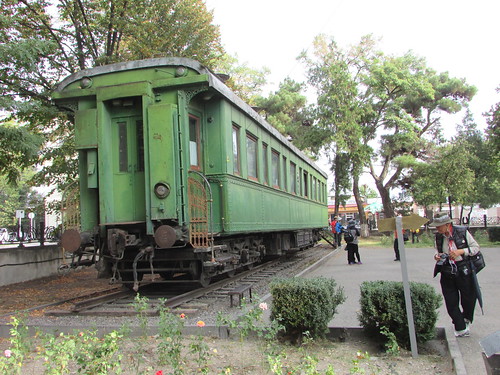
Stalin's Museum, Gori, Georgia: Stalin's private railway coach.
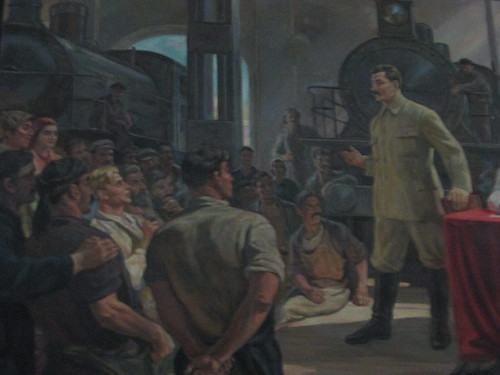
Stalin's Museum, Gori, Georgia: This painting shows Stalin addressing an admiring group of railway workers. The locomotives appear to be the ubiquitous 'E' class 0-10-0.
The museum build was started in Stalin's lifetime. He apparently objected to the term 'Stalin's Museum' and suggested 'Museum of the Revolution' but the museum was not completed until after his death and the name 'Stalin's Museum' was retained.
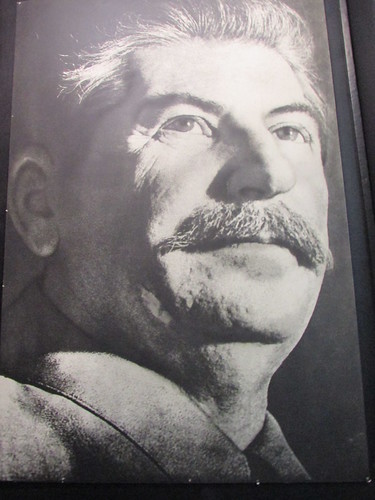
Stalin's Museum, Gori, Georgia: This photograph of Stalin shows the scarred chin resulting from smallpox at the age of seven which also left him with a slightly deformed left arm.
The buses then drove to the ancient Uplistsikhe cave settlement on the banks of the Mtkhvari River.
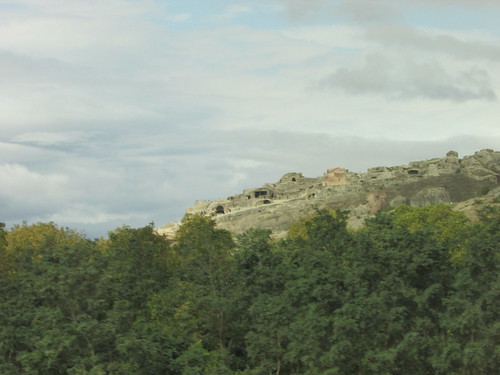 Uplistsikhe cave settlement, Georgia
Uplistsikhe cave settlement, Georgia
The briefing notes admitted that walking uphill on slippery rocks to reach the caves might be difficult but I distinguished myself by tripping up on the modern flattish path before I'd even started the climb, producing abrasions on both hands and my left knee. I was impressed by the amount of blood dripping from both hands and my travelling companions were most concerned. I sat on a bench while the tour's doctors were summoned. We had two young doctors, Samantha and Edward, both in General Practice in England and keen to explore the world. After dressing the wounds, they accompanied me as I managed to complete the ascent to the remains of the caves and the more modern Christian church at the summit. The wind was very strong and gusty making even standing up difficult.
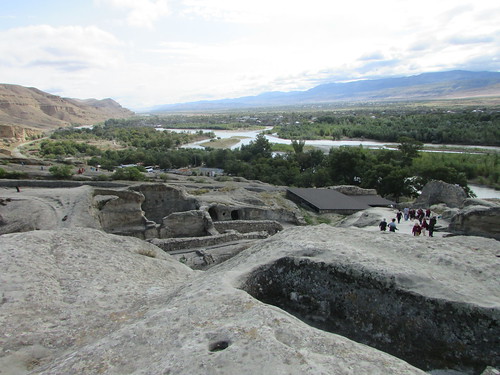
View of Mtkhvari River from Uplistsikhe cave settlement, Georgia
There's a Wikipedia article here.
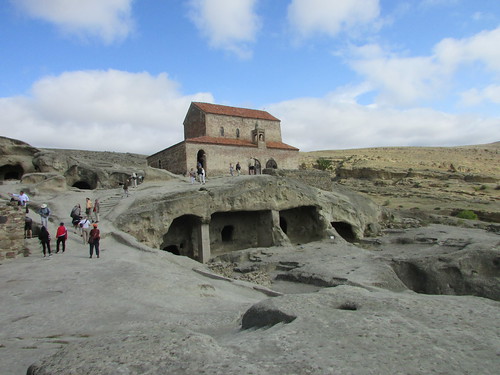
Uplistsikhe cave settlement, Georgia: 3-nave basilica circa 9th century.
Back on the bus, we then took the E60 highway towards our final attraction for the day, Mtskheta.
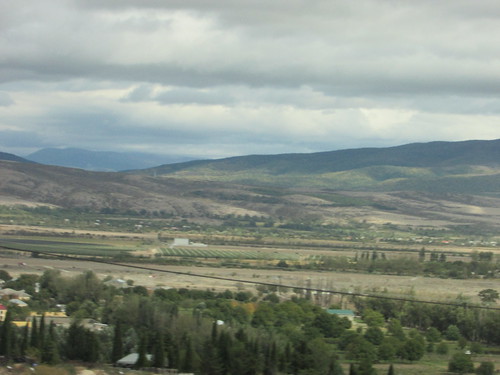
Gori-Mtskheta via the E60 highway.
Before reaching Mtskheta, we stopped for lunch at a large, modern restaurant with carefully-manicured gardens. After our meal, we completed our journey to MtsKheta, where the coaches parked on a large car park near the town centre.
Mtskheta, a World Heritage Site, was Georgia's old capital before Tbilisi. We walked from the car park to the 11th century Svetitskhoveli Cathedral, running the gauntlet of numerous tourist shops lining the route.
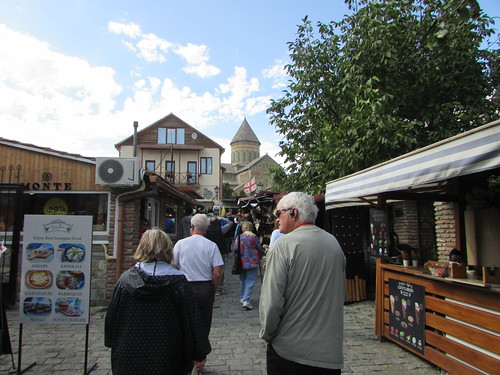
Mtskheta, Georgia: Walking to the cathedral.
This historic and imposing cathedral, built in the Eastern Orthodox tradition, is now affiliated to the Georgian Orthodox Church. It has many interesting features and Wikipedia provides a good introduction here.
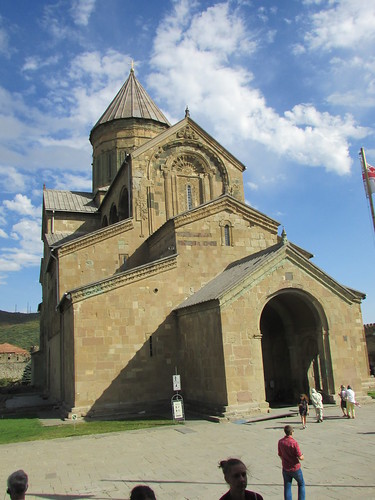
Mtskheta, Georgia: Svetitskhoveli Cathedral
My album here gives glimpses of the soaring nave, 4th century font, decorated ciborium, medieval frescoes, copy of the Chapel of Holy Sepulchre and gravestones of the World Heritage Site. Returning to our coaches, I took a picture at a shop selling the traditional Georgian snack Churchkhela. There's more in Wikipedia here. Similar snacks are also made in other countries.
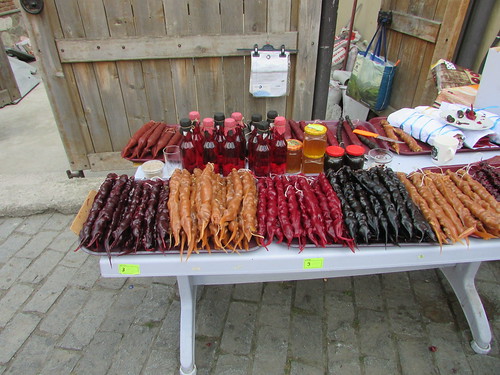
Mtskheta, Georgia: Churchkhela - local snacks on sale.
After an interesting visit, our coaches took the steep, winding road to Jvari Montastery on top of a hill overlooking the main town and the confluence of the Mtkvari and Aragvi Rivers.
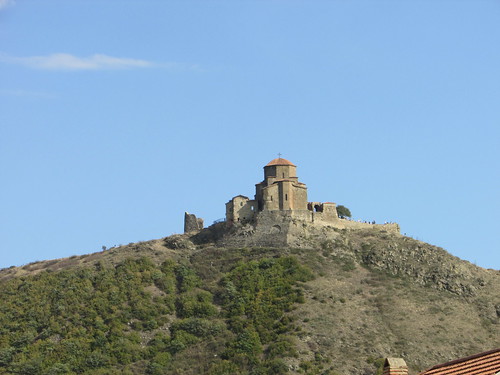
Mtskheta, Georgia: Jvari Monastery viewed from the town.
The historic Mtskheta Church of Holy Cross at Jvari, like the Cathedral earlier, was crowded with visitors. This, too, is a World Heritage Site. Built in the 6th century, its 4-apse design surmounted by a domed tetraconch influenced later Georgian church design. There's a Wikipedia article here.
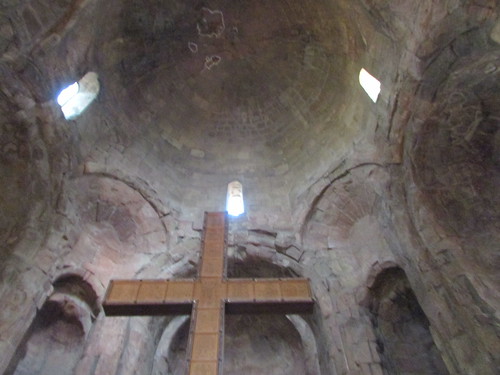
Jvari Monastery and Mtskheta Chuch of Holy Cross, Georgia, showing the dome.
Outside, the view from the windswept mountain top across the rivers and the main town were stunning.
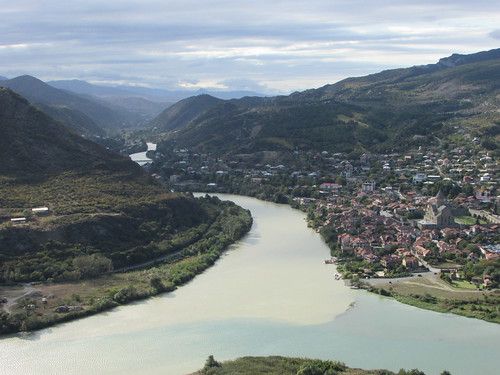
View from Jvari Monastery, Georgia showing the confluence of the Mtkvari and Aragvi Rivers with the main town (and its cathedral) on the right.
Our coaches carefully descended the winding road and rejoined the E60 highway, reaching Tbilisi after about 20 km. Whilst we were had been enjoying the day's sightseeing, our train had travelled back from Gori to Tbilisi and was waiting for us in platform 4 when we finally negotiated the usual city traffic. Our arrival was just after five p.m. and the 'Golden Eagle' train was supposed to leave Tbilisi at 17:30 to take us to Baku, the capital of Azerbaijan. However, the train was about an hour late leaving Tbilisi, presumably due to some 'operational reason' on the railway. I was able to take some 'railway' photographs for the first half-hour as we made our way south-east through the railway yards and the extensive suburbs of Tbilisi.
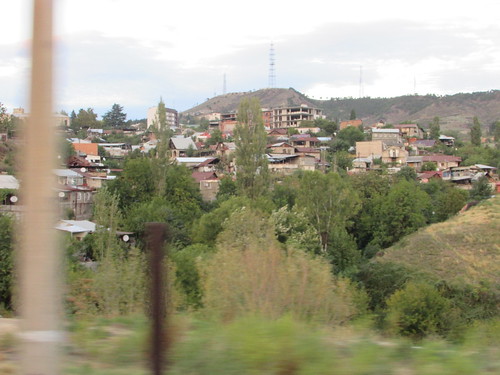
Georgian Railway: Suburbs of Tbiliisi, viewed from the 'Golden Eagle' train as we head for Azerbaijan.
After that, it became too dark to take pictures as we headed towards Gardabani, the last station before the border with Azerbaijan. The late departure meant that the carefully-choreographed timetable for passing through the Georgian border checks at Gardabani, taking dinner in the restaurant car and then passing through Azerbaijan Immigration at Beyuk-Kyasik fell apart.
Once immigration formalities at Beyuk-Kyasik were complete, we took a late dinner in the restaurant cars but our train was not allowed to proceed on its journey to Baku for some hours, by which time I was asleep.
Related posts on this website
This is one of a series of posts describing my 'Golden Eagle' Caspian Odyssey trip, starting with Travelling East.
Clicking on the 'Next report' link displays the post describing the next events. In this way, you may read about the trip in sequence.
Next report
Alternately, clicking on the 'All my Caspian Odyssey reports' link displays all the posts on this trip in reverse date-of-posting order.
All my Caspian Odyssey reports.
My pictures
These albums include pictures of the above events:-
Stalin's Museum, Gori, Georgia.
Uplistsikhe cave settlement, Georgia.
Gori-Mtskheta via the E60.
Mtskheta, Georgia.
Jvari Monastery and Mtskheta Chuch of Holy Cross, Georgia.
Tbilisi, Georgia.
Georgian Railway.
Tbilisi area rail, Georgian Railway.
All my pictures taken in Georgia (except 'technical' railway pictures) are in the collection Georgia.
[Minor edits and links to pictures added 6-Oct-2018: Edits and pictures embedded 26/27-Oct-2018]
